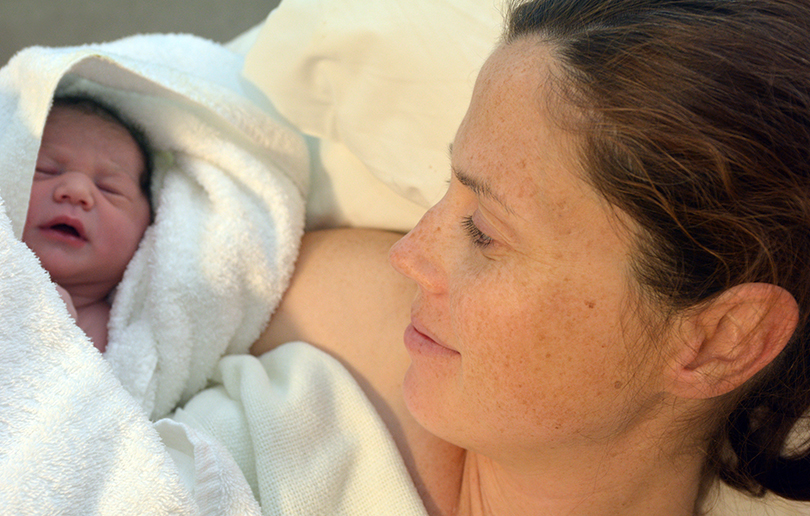All you need to know about having a water birth in the UAE
Dr Nailaa Khadum, a Specialist Obstetrician and Gynaecologist at Zia Medical Centre talks to Mother, Baby & Child about the pros and cons of having a water birth in the UAE.

What’s different about a water birth?
Water birth is when you give birth to your baby in a birth pool. Water can also be used to help you stay mobile and provide pain relief throughout labour, and this is referred to as ‘using water during labour’.
What are the benefits of water birth in the UAE?
Being immersed in water during labour can be relaxing and has pain-relief benefits because water supports your weight making it easier to move around and get into comfortable positions. Being enclosed and surrounded by water in a birth pool can also give you a sense of privacy, which in itself may help labour progress.
Some women report an increased feeling of satisfaction after giving birth in water. Water births may also be easier as water provides support, allowing you to get into an upright position which is beneficial for labour. Depending on your circumstances, such as the position of your baby, you may also be less likely to tear your perineum, the area between the opening to the birth canal and the back passage. Some women feel that having a water birth provides their baby with a more gentle transition to the start of their life even though no one can really be sure of how babies feel during labour.
What’s the downside of water birth in the UAE?
Using water in labour is not always suitable for everyone. In some circumstances, women will need closer monitoring or interventions which may not necessarily be possible in a birth pool. For example, sometimes when women are induced, their baby needs to be monitored more closely using electric sensors, and these cannot be used in a birth pool.
What extra pain relief can be taken for a water birth in the UAE?
Entonox, often called gas and air is allowed during water birth as the gas is too weak to make you feel so drowsy that you’d slip underwater. In a hospital, this is usually pumped into the delivery room or the birth pool room from a central supply.
You’ll not be allowed to use Transcutaneous Electrical Nerve Stimulation (TENS) as this is electrical and therefore not compatible with water, nor would you be allowed pethidine, or other injectable drugs which could make you drowsy. An epidural, which involves a fine tube being inserted into your back is also not usable in the birthing pool.
What will the water birth be like for your baby?
Babies have a natural ‘dive reflex‘ whereby they close their airway and don’t take a breath in water, so you need not worry that they’re going to swallow a big mouthful of your pool water as they emerge. Babies born into warm water often appear far more relaxed and don’t even cry until they’re dried and air hits their cheeks. It’s thought that the pool feels like the comforting waters of your womb to your baby. Supporters of birthing pools believe that the transition to the outside world is less traumatic for babies who are born in water.
Is it possible that my baby could inhale water?
The fact is that babies are only at risk of inhaling water if their head is brought to the surface before the rest of their body is born, overriding their dive reflex or if their oxygen supply via the placenta is affected in some way.
Your midwife, if present, will know she needs to be careful as your baby is being born so that she doesn’t interfere with her dive reflex. She’ll also guide you to make sure you don’t bring your baby’s head to the surface before the rest of their body is born.
Are there any risks of infection?
There is no statistical evidence that there is any more risk of an infection with a water birth than there is with a natural one. Moreover, hospitals are meticulous when cleaning pools after every water birth and conduct regular checks to ensure that the pool is hygienic after use.
What reasons are they for not seeing a water birth through to the end?
There are several reasons why you may have to give up on a water birth and resort to a conventional setting. If your contractions are too strong for you and the birthing pool is not making you relax, then you may have to give it up and go for another pain relief option such as TENS, pethidine or an epidural.
You will be asked to leave the pool if: Your labour is progressing too slowly, there is a problem with your baby’s heartbeat, you start bleeding during labour or if your blood pressure rises or if you feel faint or drowsy
What about the umbilical cord?
As the baby is lifted from the water by your midwife, special care will be taken to avoid pulling on the cord, just in case it is shorter than normal.
And after the birth?
Some doctors and midwives have observed how calm babies were after being born in water, crying less, appearing more relaxed, also eager to have eye contact with their mothers and suckle.
How is the placenta delivered?
Many hospitals and birth centres have a policy which requires the mum to get out of the pool for the delivery of the placenta, so you may be asked to leave the pool for this stage. Water birth is among several birth methods you can choose from. Make sure you choose whatever makes you feel comfortable and safe, and don’t forget to reach out for more information from the professionals if needed to help you welcome baby into the world.










